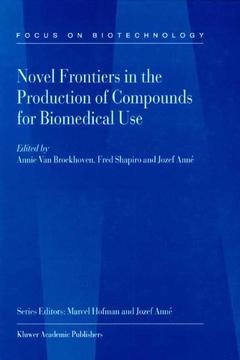Description
Novel Frontiers in the Production of Compounds for Biomedical Use, 2001
Focus on Biotechnology Series, Vol. 1
Coordinators: van Broekhoven A., Shapiro Fred, Anné Jozef
Language: English
Subjects for Novel Frontiers in the Production of Compounds for...:
Keywords
Biomaterial; Biomedical application; DNA; biochemistry; biotechnology; cells; proteins
Novel Frontiers in the Production of Compounds for Biomedical Use
Publication date: 12-2010
454 p. · 15.5x23.5 cm · Paperback
Publication date: 12-2010
454 p. · 15.5x23.5 cm · Paperback
Novel frontiers in the production of compounds for biomedical use - volume 1 (focus on biotechnology, 1)
Publication date: 02-2001
454 p. · 15.5x23.5 cm · Paperback
Publication date: 02-2001
454 p. · 15.5x23.5 cm · Paperback
Description
/li>Contents
/li>
The present book entitled ?Novel Frontiers in the Production of Compounds for Biomedical Uses? can perhaps be placed in its best perspective by the Shakespearean character in The Tempest who exclaimed" What?s past is prologue?. Indeed, this compilation of some of the outstanding presentations in the field of biomedicine made at th the 9 European Congress on Biotechnology (Brussels, Belgium, July 11-15, 1999) not only reflects the achievements of the recent past, but provides a privileged glimpse of the biotechnology that is emerging in the first decade of the new Millennium. It is becoming increasingly apparent that biotechnology is offering biomedicine novel approaches and solutions to develop a sorely needed new generation of biopharmaceuticals. This is all the more necessary because in recent years, new diseases have emerged with extraordinary lethality in all corners of the globe, while age-related chronic illnesses have filled the gap wherever biomedicine has made successful inroads. The rise of antibiotic resistance also poses major threats to public health. Thus, as disease patterns evolve, the rational development of new drugs is becoming urgent, not only for the clinical outcome of patients, but also in optimising the allocation of scarce health care resources through the use of cost-effective productions methods. It is in response to all these challenges that biotechnology offers new strategies that go beyond the more traditional approaches. By the mid-1990?s, the number of recombinant products approved annually for therapeutic use reached double digits. With the advent of the genomics revolution.
Genomics: the New Approach to the Discovery of New Compounds.- The Genomics Approach: Is it Really the Solution?.- The Contribution of Genomics to the Discovery of New Antibiotics.- Antibiotics.- The Antibiotic Gallidermin-Evolution of a Production Process.- Resistance to ?-Lactams, a Self-Regenerating Problem.- Resistance to aminoglycoside Antibiotics: Function meets structure.- The Genetics and Biochemistry of Resistance to Glycopeptide Antibiotics.- ?-Lactamases, an Old but Ever Renascent Problem.- Metabolic Flux Analysis in Streptomyces Coelicolor: Effect of nitrogen source.- Metabolic Engineering of the Lysine Pathway for ?-Lactam Overproduction in Penicillium Chrysogenum.- Glycosylation of Antibiotics and Other Agents from Actinomycetes.- Enzymatic Synthesis of Amoxicillin.- Production of Therapeutic Antibodies.- New Recombinant Bi- and Trispecific Antibody Derivatives.- Advantages of Single-Domain Antigen-Binding Fragments Derived from Functional Camel Heavy-Chain Antibodied.- Heterologous Protein Production: New Production Strategies.- Furin as a Tool for the Endoproteolytic Maturation of Susceptible Recombinant Biopharmaceuticals.- Development of Bioprocesses for the Generation of Anti-Inflammatory, Anti-Viral and Anti-Leukaemic Agents.- Apoptosis and Bioprocess Technology.- Gram-Positive Bacteria as Host Cells for Heterologous Production of Biopharmaceuticals.- Multiple Pathways of Exoprotein Secretion in Gram-Negative Bacteria.- Alteration of Metabolic Flux Distributions in Recombinant Escherichia Coli in Response to Heterologous Protein Production.- Dynamics of Proteolysis and its Influence on the Accumulation of Intracellular Recombinant Protein.- Artificial Organs and Xenografting.- The Impact of Transgenesis and Cloning on Cell and OrganXenotransplantation to Humans.- Reinforced Bioartificial Skin in the Form of Collagen Sponge and Threads.- Antitumour Compounds.- Towards the Generation of Novel Antitumour Agents from Actinomycetes by Combinational Biosynthesis.- Cell Immobilisation of Taxus Media.- Pre and Probiotics.- The Role of Prebiotics in Human Gut Microbiology.- The Influence of Intestinal Microflora on Mucosal and Systemic Immune Responses.
© 2024 LAVOISIER S.A.S.
These books may interest you

Emerging Areas in Bioengineering 362.12 €



